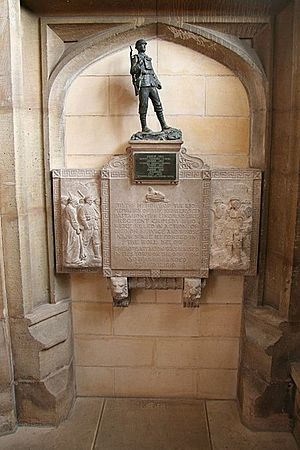Grimsby Chums facts for kids

The Grimsby Chums was a special group of soldiers from Grimsby and nearby towns in Lincolnshire. They joined the British Army during the First World War in 1914. They were part of something called a "Pals battalion," which meant friends, neighbours, and co-workers could all join and fight together. This group was officially known as the 10th (Service) Battalion of The Lincolnshire Regiment. It was unique because it was the only "Pals battalion" to be called "Chums."
Contents
How the Grimsby Chums Were Formed
When the war started, Lord Kitchener, a famous British general, asked for volunteers to join the army. Many men wanted to help.
The headmaster of Wintringham Grammar School in Grimsby had an idea. He wanted to create a group of 250 former students to fight together. This group would train at the school's Officer Training Corps armoury.
At first, this group was offered to a local army unit, the 5th Battalion, Lincolnshire Regiment. But that unit was already full! So, other men from Grimsby also wanted to join. The town council then took over the effort. They worked hard to find enough men to form a whole new battalion for "Kitchener's Army."
Men from nearby towns like Boston, Louth, and Scunthorpe also joined the Grimsby Chums. To make sure the battalion was complete, some men even came from Wakefield in Yorkshire.
Joining the Fight
The Grimsby Chums became part of the 101st Brigade. This brigade was part of the 34th Division in the British Army. They were joined by two other "Pals" battalions from Edinburgh, Scotland.
In January 1916, the entire division moved to France. This was where much of the fighting in the First World War happened. The Grimsby Chums first saw action in a very famous and difficult battle called the Battle of the Somme.
The Battle of the Somme
The first day of the Battle of the Somme was 1 July 1916. The Grimsby Chums were among the first soldiers to attack. Their target was a strongly defended German village called La Boisselle. This village was located just south of the main road between Albert and Bapaume.
To help their attack, a huge mine was dug under the German trenches. This mine was known as the Lochnagar mine. At 7:28 AM, just two minutes before the attack was set to begin, the mine was blown up. It created a massive crater.
At 7:30 AM, the Grimsby Chums rushed forward. Their goal was to take control of this huge crater. However, many soldiers became trapped there for the rest of the day. They were caught between German and British artillery fire, which was very dangerous.
A few of the Grimsby Chums did manage to reach the German trenches. One officer, 2nd Lieutenant Harold P. Hendin, led five men into the third German trench. As the day went on, more soldiers joined him. He bravely held off many German counter-attacks before finally having to retreat.
Heavy Losses
The first day of the Somme was incredibly tough for the Grimsby Chums. On 1 July 1916, they suffered 502 casualties. This means 15 officers and 487 other soldiers were either killed, wounded, or went missing. Only two officers came back without injuries, and only about 100 men returned unharmed.
After the Somme
In February 1918, the battalion moved to a different unit, the 103rd Brigade, which was still part of the 34th Division. The 10th Battalion, the Grimsby Chums, was officially disbanded on 3 June 1919, after the war ended.
Remembering the Chums
A special memorial was built in St James' Church in Grimsby. This memorial remembers the 810 members of the 10th (Service) Battalion who were killed in action or died while serving their country.

